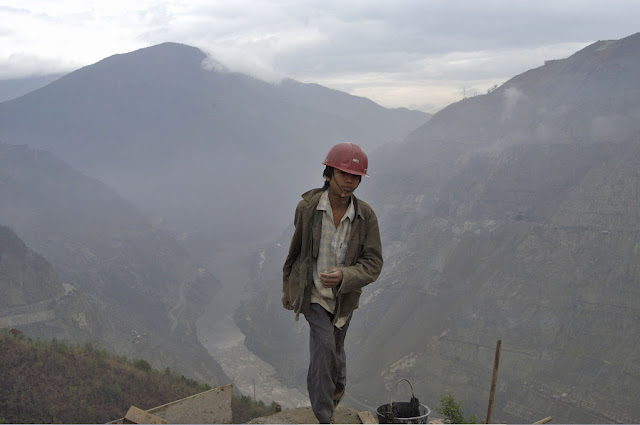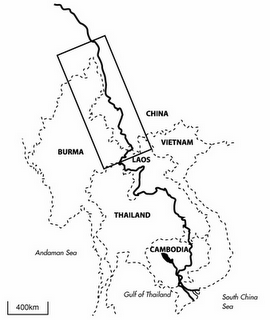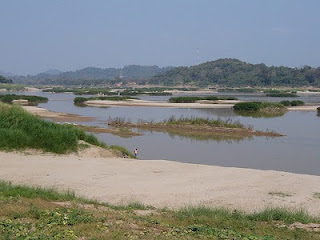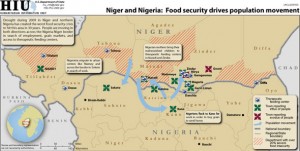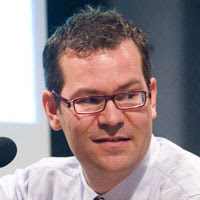Showing posts from category demography.
-
Robert Engelman, Worldwatch Institute
The Number Left Out: Bringing Population Into the Climate Conversation
›December 9, 2010 // By Wilson Center Staff Numbers swirl around climate change.
Numbers swirl around climate change.
So many parts per million of greenhouse gases in the atmosphere. So many gigatons of carbon dioxide emitted. So many degrees Celsius of temperature rise that we hope won’t happen. Yet one number rarely comes into play when experts or negotiators talk about the changing atmosphere and the warming of the planet: the number of humans putting heat-trapping gases into the air.
The original version of this article, by Robert Engelman, appeared on the Worldwatch Institute’s Transforming Cultures blog.
The UK Met Office’s data set for September 2009 of more than 1,600,000 temperature readings from 1,700+ stations.
Numbers swirl around climate change.
So many parts per million of greenhouse gases in the atmosphere. So many gigatons of carbon dioxide emitted. So many degrees Celsius of temperature rise that we hope won’t happen. Yet one number rarely comes into play when experts or negotiators talk about the changing atmosphere and the warming of the planet: the number of humans putting heat-trapping gases into the air.
The relative silence isn’t hard to understand. Population is almost always awkward to talk about. It’s fraught with sensitivity about who has how many children and whether that is anyone else’s business. It’s freighted with sexuality, contraception, abortion, immigration, gender bias, and other buttons too hot to press into conversation. Yet two aspects of population’s connection to climate change cry out for greater attention – and conversation.
One is that population – especially its growth, but other changes as well – matters importantly to the future of climate change, a statement that as far as I can tell is not challenged scientifically. (The Intergovernmental Panel on Climate Change, for example, accepts the accuracy of the so-called Kaya identity, which names population among the four factors that determine emissions growth from decade to decade.) And, two, addressing population in climate-friendly ways is also fundamentally people-friendly, in that it involves no “population control,” but rather the giving up of control – especially control of women’s bodies by people other than themselves.
A new Worldwatch Institute report, which I authored, offers details, findings, and recommendations on both the importance of population in climate change and how to address it. The report looks at some of the history of the population-climate link – in particular, interesting work by William Ruddiman, who hypothesizes that the agricultural revolution contributed to global warming thousands of years ago. And it addresses the common objection that population growth can’t be that important in greenhouse gas emissions growth because countries with high per capita emissions tend to have smaller families than low-emitting countries.
Equity in per capita emissions, I argue, is an essential goal – and without it, no global effort to shrink emissions can succeed. The imperative of an equal sharing of atmospheric carbon space is among the most powerful arguments for a smaller world population. When greenhouse gases other than carbon dioxide – such as methane and “black carbon” – are considered, per capita emissions gaps are not as wide as many writers believe. And the amount of all these gases that equal emitters can contribute without altering the atmosphere shrinks in direct proportion to population’s growth.
Arguments about population’s role in climate change are unnecessarily heated, however. Even if the growth of human numbers played only a minor role in emissions growth, it would be worth discussing – not because addressing population will somehow resolve our climate predicament, but because ultimately no other strategy on its own will either. We need the widest possible range of strategies – economic, political, technological, and behavioral – that are both feasible and consistent with shared human values.
On population, the most effective way to slow growth is to support women’s aspirations. Almost all women aspire to gain an education, to stand in equality with men, and to make decisions for themselves – including whether and when to give birth. Policies and programs to help women achieve these aspirations exist in many places. But they don’t get the attention, support and funding they deserve. And they are rarely seen as climate-change strategies.
As societies, we have the ability to end the ongoing growth of human numbers – soon, and based on human rights and women’s intentions. This makes it easy to speak of women, population, and climate change in a single breath.
Robert Engelman is vice president for programs at the Worldwatch Institute and the author of “Population, Climate Change, and Women’s Lives.” Please contact him if you are interested in a copy of the report.
Sources: UK Met Office, World Resources Institute.
Image Credit: Adapted from “Met Office Climate Data – Month by Month (September),” courtesy of flickr user blprnt_van, and report cover, courtesy of the Worldwatch Institute. -
Empowering Women in the Muslim World
›December 2, 2010 // By Wilson Center StaffOriginally featured in the Wilson Center’s Centerpoint, November 2010.
For decades, women in the Middle East have actively struggled for equal status before the laws of their respective countries. They have strived to attain equal participation in politics and society, and progressive justice throughout the region. While they have made progress in some parts of the region, many challenges remain. The Wilson Center’s Middle East Program recently held three meetings to discuss challenges as well as progress to empowering women across the Muslim world.
A Modern Narrative
The American Islamic Congress (AIC) recently published a report, “A Modern Narrative for Muslim Women in the Middle East: Forging a New Future,” that highlights past and present triumphs and difficulties – economic, legal, political, religious, and social –for women’s rights throughout the region. On September 30, the Middle East Program co-sponsored a meeting with the AIC to review the status of women in Saudi Arabia and Jordan, based on findings in the AIC’s report.
Fawziah Al-Hani, manager of the Gherass Center for Social Education in Saudi Arabia, expressed frustration about the progress women have made in her native Saudi Arabia. She said women there are perceived as second-class citizens by the country’s legal, economic, political, religious, and social institutions. Women’s issues are rarely discussed in Saudi political and social spheres, and women are not represented in government or the business sector. She said if women are allowed to be active outside the home, they are mostly restricted to educational and health activities.
While she is frustrated about these restrictive Saudi policies toward women, Al-Hani said she maintains hope, as changes take place within the society and government through new initiatives and movements.
Rana Husseini, a human rights activist, author, and journalist, detailed the changes to the status of women in Jordan over the past 20 years. Husseini, whose human rights activities over the past two decades in Jordan have focused on honor crimes and other women’s issues, said Jordan has made substantial progress on women’s rights as a result of intense media and civil society activism. While there is room for improvement, she said women are now participating in government and significant reforms have been made to the judicial system.
Though the effectiveness of quotas for women in government may be debated, Husseini noted that quotas facilitate women’s participation in elections and government service. In fact, she said, there are some 50 women judges in Jordan. She noted that honor killings, except in extreme cases, are becoming rarer, and harsher sentences are being imposed for honor crimes.
With constant pressure on the government and society, reforms will continue, said Husseini, who is optimistic about the future for women rights in Jordan and in the Middle East as a whole.
Demographic Realities
Why do many Middle Eastern women not enjoy the same economic opportunities as women of other regions? Can they be empowered to participate at a greater level? Nadereh Chamlou, a senior adviser at the World Bank, attributed the gender inequality to restrictive social norms. She said the region’s women must be empowered to participate in a more significant way if their countries are to effectively exploit, instead of squander, the current economic “window of opportunity.”
At a September 13 discussion, Chamlou said the good demographic news is that there are high numbers of working-age people and thus the potential for rapid economic growth. However, Middle Eastern countries have the highest dependency rates in the world, a fact that Chamlou attributed to the low economic participation of Middle Eastern women relative to female citizens’ participation in other parts of the world. This reality means the Middle East’s demographic composition will not be exploited to its full potential.
Increasing economic opportunities for women will require changing social norms, said Chamlou. She cited a study conducted by the World Bank in three Middle Eastern capitals – Amman, Jordan; Cairo, Egypt; and Sana’a, Yemen – that revealed the biggest reason for the poor representation of women in the workforce is the negative male attitude regarding women working outside the home. Notably, social norms and such negative male attitudes proved to restrict women’s participation far more than the need to attend to child-rearing duties. Despite the successful efforts of most Middle Eastern states to improve education opportunities, conservative social norms still pose a barrier to female empowerment.
Some simple changes could have a substantial impact. Chamlou recommended focusing on educated, middle-class women, undertaking more efforts to bring married women into the workforce, and emphasizing changing attitudes – particularly among conservative younger men – toward women working outside the home.
Lessons from Tunisia
In Tunisia, the progress of women’s empowerment can serve as a model for the region, noted women’s rights advocate Nabiha Gueddana, president and director-general of the National Agency for Family and Population in Tunisia.
Speaking at a September 8 meeting, Gueddana said the Arab world can learn much from her native Tunisia regarding the positive effects of empowering women. Gueddana, also a candidate for undersecretary-general of UN Women at the United Nations, described how Tunisian women have been empowered politically, economically, and socially, and how this empowerment has benefited Tunisian society.
Tunisia has undergone substantial changes since achieving independence from France in 1956. Tunisian women had second-class status in the years prior, a time Gueddana described as one that relegated them to a life of constant child-rearing, illiteracy, and economic dependence.
Yet Tunisia has become a beacon for other Muslim societies: the country’s labor code allows full female participation in the economy and education is open equally to boys and girls. Family planning programs and important strides in health have considerably lowered the birth rate and lengthened the life expectancy of the average woman. Gueddana also noted that Tunisia’s economic growth is now five times greater than the growth rate of its population.
Measures to empower women in Tunisia have benefited not only women but Tunisian society as a whole, with significant shifts in men’s attitudes regarding women’s rights and roles in society. Gueddana indicated that her efforts extend beyond Tunisia, as she strives to help empower women throughout the world. She said such efforts will persist so long as women anywhere find themselves disadvantaged, dependent, and living as second-class citizens.
Women’s empowerment in society rests increasingly not in the political but in the economic and business domains (Editor’s note: one could add that women’s empowerment has the potential to considerably impact the environmental domain as well). While women have made considerable progress in the political arena, economic power is still male-dominated throughout the region.
Gueddana said the discussion of women’s rights should take place within the broader context of human rights. Violence against women, particularly sexual violence, is a widespread phenomenon across all societies and, unfortunately, often considered taboo for discussion. She said all citizens benefit when all have equal rights and can use them to expand their opportunities and achievements to enhance their societies.
Dana Steinberg is the editor of the Wilson Center’s Centerpoint.
Photo courtesy of Centerpoint. -
Managing the Mekong: Conflict or Compromise?
›December 1, 2010 // By Russell SticklorAt nearly 5,000 kilometers long, the Mekong River is one of Asia’s most strategically important transboundary waterways. In addition to providing water for populations in the highlands of southern China, the Mekong helps support some 60 million people downstream in Southeast Asia, where the river is a key component of agricultural production and economic development.
In recent years, however, the Mekong has emerged as a flashpoint for controversy, pitting China against a coalition of downstream nations that includes Thailand, Laos, Cambodia, and Vietnam. The countries of the Lower Mekong argue that Beijing’s construction of multiple dams on the Upper Mekong is robbing them of critical water resources, by decreasing both the quality and quantity of water that makes it through Chinese floodgates and spillways. China, however, mindful of soaring energy demand at home, has continued its campaign to harness the hydroelectric potential of the Upper Mekong and its tributaries – but at what cost to the environment and Beijing’s relationships with Southeast Asia?
China’s Hand on the Faucet
China’s total energy demand just recently passed the United States and is expected to continue to increase in the near-term – by 75 percent over the next 25 years, according to the International Energy Agency.
As a result, Beijing has been looking to bolster its energy security by reaching out to develop energy resources in Africa, Latin America, and the Middle East, as well as along the Mekong and in the East and South China Seas.
In that context, China’s aggressive hydroelectric development of the Upper Mekong — known in China as the Láncang Jiang (shown in the boxed area of the map at right) — makes perfect sense. The river’s sizeable elevation drops make it a rich source of energy; already, 15 large-scale dams have either been completed or are under construction on the Upper Mekong in Tibet and Yunnan.
Those dams also provide China with enormous geopolitical leverage over downstream nations. With little more than the flick of a switch, the Chinese government could substantially curtail the volume of flow entering the Lower Mekong basin. Doing so would of course be tantamount to an act of war, since depleted flow volumes in the Lower Mekong would hinder crop irrigation, jeopardize food security, and endanger the health of the region’s economically critical freshwater fisheries, which are among the world’s most productive. Chinese floodgates and spillways essentially give Beijing de facto control over Southeast Asia’s water security.
The View Downstream
To date, China has never threatened to deliberately reduce the flow of the Mekong to its downstream neighbors. Nevertheless, the perception of threat in Southeast Asian capitals remains high.
Already, a number of the region’s governments — represented formally through the Mekong River Commission, a 15-year-old organization that China still has not joined as a full-fledged member — have complained that completed or in-progress Chinese dams are resulting in less water entering their countries, a phenomenon that becomes particularly pronounced during periods of drought, as observed this summer. Further, there is also the issue of water quality. Since Chinese dams trap silt being flushed out of the Himalayas, that nutrient-rich material cannot be carried downstream, where it historically has helped create fertile soils in the floodplains of the Lower Mekong basin.
Quality and quantity concerns aside, there are also structural issues concerning how Beijing goes about its business on the Upper Mekong. Since it is only a “Dialogue Partner” to members of the Mekong River Commission, China is not required to seek approval from downstream nations on hydroelectric development of the river’s Chinese stretch, even though that development has both direct and indirect implications for water security in the Lower Mekong basin. China has even shown a penchant for deliberate secrecy as it develops its stretch of the river, choosing to share a minimal amount of hydrological data with downstream neighbors and typically refraining from even announcing new dam projects.
“The Security Implications Could Hardly Be Greater”
Given its geographic position, Cambodia is particularly vulnerable to China’s stewardship decisions. With one of the poorest populations in Southeast Asia and also one of the highest fertility rates, at 3.3 births per woman, the potential for water scarcity issues is real. By mid-century, its population is projected to jump from its current 15 million to nearly 24 million.
“The government of Cambodia will be entirely at the mercy of Beijing,” said Wilson Center Scholar and Southeast Asian security expert Marvin Ott. “For Cambodia, the question becomes how they can curry China’s favor so as to avoid coercive use of the Mekong — or find some way of exerting counter-pressure on Beijing.”
Overall, population for mainland Southeast Asia is projected to rise from its current 232 million to 292 million by 2050. This growth will require increased agricultural output across the region and thus increased reliance on the waters of the Lower Mekong. The Lower Mekong nations’ shared dependency on the river and China’s continued unilateralism in the Upper Mekong could have serious repercussions for the region, said Ott:The security implications could hardly be greater for the downstream states. With the dams, China will have literal control over the river system that is the lifeblood of Laos, Cambodia, and Vietnam. The power this gives China is equivalent to an invasion and occupation of a country by the Chinese army.
For its part, the PRC maintains that water woes in the Lower Mekong are not its doing. In response to the chorus of Southeast Asian claims that China diverts or stores more than its fair share of water, Beijing’s typical refrain has been that blame for low water levels downstream lies not with Chinese water resource management but with heightened precipitation variability associated with climate change. Chinese water officials also contend that the Lower Mekong countries’ complaints are misdirected because water from the Chinese-controlled sections of the Upper Mekong basin accounts for less than 20 percent of the Mekong’s total flow volume by the time the river reaches its natural outlet in the South China Sea.
There are some indications, however, that China may be experimenting with a more open approach to engaging downstream nations. Earlier this year, China overturned precedent by offering top Southeast Asian government officials a tour of what had once been a top-secret hydro project, the mammoth Xiaowan dam. Some critics insisted Beijing’s fear of growing U.S. influence in the Lower Mekong helped motivate the rare show of transparency, while others said it was a means to curry favor with Southeast Asian nations so that they would support China’s controversial resource-development strategies in the South China Sea. Yet regardless of motive, Beijing’s move away from secrecy – if sustained – could do a great deal to smooth over regional tensions.
Dammed If You Do, Damned If You Don’t
Beyond some limited transparency, Beijing also hopes to mitigate concerns about development of the Upper Mekong by offering funding or logistical support for similar large-scale hydroelectric facilities on the Lower Mekong. The move has been largely welcomed by the Mekong River Commission countries, which envision dams of their own generating much-needed energy input for national grids, accelerating continued economic modernization, and enhancing flood control. As of 2009, there were 12 dam projects for stretches of the Mekong south of the Chinese border and many more planned for key tributaries.
The danger in such deal-making is that the environmental costs will be lost in the shuffle. A series of major dams would fundamentally alter the Mekong’s hydrology, which could lead to the degradation of sensitive riverine ecosystems, the disruption of upstream migratory routes for fish that serve as local dietary staples, and the decline of fresh water fisheries that form the backbone of many local economies.
Given the long-term effects on the food, environmental, and economic security of the Lower Mekong heartland, Beijing’s attempt to ease water tensions with a new round of dam construction may end up doing far more harm than good. Unfortunately, with both China and the Mekong River Commission countries currently viewing the dam proposals as something of a win-win, planning and construction are likely to move forward over the coming years.
Sources: Financial Times, Foreign Policy, International Institute for Strategic Studies, Los Angeles Times, Mekong River Commission, National Geographic, New Asia Republic, Phnom Penh Post, Population Reference Bureau, Stimson Center.
Photo Credits: “Xiaowan Dam Site (Yunnan Province, China, 2005),” (Top) courtesy of flickr user International Rivers; Map (Middle) courtesy of International Rivers; “Thailand – Isaan, Mekong River,” (Bottom) courtesy of flickr user vtveen. -
Watch: Blue Ventures PHE Program in Madagascar
›“All conservation efforts will be in vain if family planning issues aren’t addressed,” says Rebecca Hill, project manager for the Sexual and Reproductive Health Programme at Blue Ventures in a video highlighting their population, health, and environment (PHE) programming in Madagascar.
While primarily a marine conservation group, Blue Ventures also recognizes the need for integrating population into their efforts. They began a family planning program in southwestern Madagascar in 2008 as part of a “holistic approach to conservation.” The project aims to address the high unmet need for family planning, high fertility and maternal and infant mortality, and conserve the coastal environment. “We are directly saving lives,” Hill says.
Rapid population growth is creating an unsustainable strain on natural resources, as Matthew Erdman of Blue Ventures wrote in a previous post on The New Security Beat:The average total fertility rate in Velondriake is 6.7 children per woman, according to our data. On average women are only 15 years old when they first conceive. To compound this problem, a majority of the population is under the age of 15 – at or approaching reproductive age. At the current growth rate, the local population will double in only 10 to 15 years. The local food sources, already heavily depleted, barely feed the current population, let alone twice that amount. Without enabling these coastal communities to stabilize their population growth, efforts to improve the state of marine resources and the community’s food security are considerably hindered.
Hill describes the situation in the village when she joined the Blue Ventures in 2008 as “alarming,” with women “having up to 17 children despite not wanting children.” Many people in the town had never heard of condoms and had no idea how to use them, she said, and “they are desperate to have access to contraception.”
Today, the initial family planning program has been scaled up to the surrounding region and generated significant community involvement by peer educators teaching community members about sexual and reproductive health. It’s also become the first PHE project to receive support from the UNFPA within Madagascar.
There are currently 18 community-based distributors who give out two types of contraception in their villages. The fact that the community has so fully embraced the project shows that it can be replicated elsewhere, says Hill in the video. “Communities themselves have harnessed the ideas and consider that what we’re doing is vitally important.”
“Addressing family planning needs and issues is inextricably linked with conservation issues,” says Hill. “All conservation efforts will be in vain, if family planning issues are not addressed.”
Video Credit: Blue Ventures Family Planning Project from Alexander Goodman on Vimeo. -
Nigeria’s Future Clouded by Oil, Climate Change, and Scarcity [Part Two, The Sahel]
›November 19, 2010 // By Schuyler NullIf southern Nigeria’s demographic and environmental problems have helped fuel today’s conflicts, it’s the north’s issues that may feed the conflicts of tomorrow.
Nigeria’s lack of development and poor governance is not exclusive to the delta region, only more well-known because its oil reserves. The north of the country, which is predominately Muslim and accounts for more than half of Nigeria’s population, faces many of the same problems of environmental degradation, lack of jobs, and inadequate infrastructure. Northern Nigeria is also growing much faster than the south, with a total fertility rate of 6.6 children per woman, compared to 4.6 in the southern states. The median age of first-time mothers in northern Nigeria is only 18 years old.Nigeria holds nearly a fifth of the entire population of sub-Saharan Africa. By 2050, it’s expected to pass Indonesia, Brazil, and Bangladesh and take its place among the top five most populous countries in the world, according to UN estimates. But a litany of outstanding and new development, security, and environmental issues – both in the long-troubled Niger delta in the south and the newly inflamed north – present a real threat to one West Africa’s most critical countries.
If southern Nigeria’s demographic and environmental problems have helped fuel today’s conflicts, it’s the north’s issues that may feed the conflicts of tomorrow.
Nigeria’s lack of development and poor governance is not exclusive to the delta region, only more well-known because its oil reserves. The north of the country, which is predominately Muslim and accounts for more than half of Nigeria’s population, faces many of the same problems of environmental degradation, lack of jobs, and inadequate infrastructure. Northern Nigeria is also growing much faster than the south, with a total fertility rate of 6.6 children per woman, compared to 4.6 in the southern states. The median age of first-time mothers in northern Nigeria is only 18 years old.
Climate, Culture, and Discontent in the North
Last summer, in an offensive that stretched across four northern states, a hardline Islamist group called Boko Haram emerged suddenly to challenge the government, attacking police stations, barracks, and churches in escalating violence that claimed more than 700 lives, according to The Guardian. The government responded with a brutal crackdown, but recent targeted killings and a prison break seem to indicate the group is back.
Perhaps most distressingly, Boko Haram appears to have won some local support. Said one local cloth trader to The New York Times in an interview this October, “It’s the government’s fault. Our representatives and our government, they are not sincere. What one person acquires is enough to care for a massive amount of people.”
As in the south, mismanagement of natural resources has also played a role in creating a dangerous atmosphere of distrust in the government. After gold was discovered this spring in northwestern Nigeria, many under- and unemployed flocked to the region to try their luck, but they also unwittingly contaminated local water with high levels of lead. Although the state health officials say they have now identified more than 180 villages thought to be affected, the epidemic was only discovered after a French NGO stumbled upon it while testing for meningitis in June. More than 400 infant deaths have been connected to the mining, according to Reuters.
Contributing to natural resource-related misery in the north are climatic changes. Declining rainfall in the West African Sahel over the last century has pushed rain belts successively south, driving pastoralists into areas often already occupied. According to Anthony Nyong’s work, presented in ECSP Report 12, these changes have elevated competition over natural resources to the single most common cause of conflict in northern Nigeria in recent years. In addition to the long-term trend of declining rainfall, an acute drought in 2009 and another this year in neighboring Niger and Chad have created the worst food security crisis in 30 years. The droughts have also driven a great deal of cross-border migration into Nigeria, which itself saw lower than usual rainfall in the north, especially the northeast, around the ever-disappearing Lake Chad (see map above for resulting migration patterns).
In addition to the long-term trend of declining rainfall, an acute drought in 2009 and another this year in neighboring Niger and Chad have created the worst food security crisis in 30 years. The droughts have also driven a great deal of cross-border migration into Nigeria, which itself saw lower than usual rainfall in the north, especially the northeast, around the ever-disappearing Lake Chad (see map above for resulting migration patterns).
What rain did fall in the border areas fell suddenly and torrentially, causing rampant flooding that affected two million people. The floods not only caused physical damage but also came just before harvest season, destroying many crops and further reducing food security. Made more vulnerable by the number of displaced people and flooding, the area was then hit with its worst cholera outbreak in years, which has killed 1,500 people so far and spread south.
Cholera is not the only preventable disease to flourish in northern Nigeria in recent years. In 2003, cleric-driven fear of a U.S. plot to reduce fertility in Muslim women caused the widespread boycott of a UN-led polio vaccination drive. The fast-spreading disease then emerged in six of Nigeria’s neighbors where the disease had previously been eradicated. The northern states today remain the only consistently polio-endemic area in Africa, according to the Global Polio Eradication Initiative.
“A Stable Nigeria Is a Stable Africa”
Nigeria’s size and its wealth of natural resources make it a strategically important country for the future of the region. “A stable Nigeria is a stable Africa,” said Wilson Center scholar and former NEITI officer Uche Igwe in an interview. “Nigeria is 150 million people and the minute Nigeria becomes unstable, the West Africa sub-region will be engulfed.”
While there have been some strides in recent years in reducing corruption and addressing infrastructure needs (for example, NEITI’s work to promote revenue transparency), the development, health, environmental security, and human security situations remain dire in many parts of the country. With one of the fastest growing populations in the world and severe environmental problems in both the north and the south, scarcity will almost certainly be a challenge that Nigeria will have to face in the coming years. How the government responds to these challenges moving forward is therefore critical.
In 2008, in response to high oil prices, British Prime Minister Gordon Brown announced his intentions to send military aid to help combat Niger Delta militants. The statement was met with dismay from humanitarian organizations and caused the collapse of a ceasefire (which was then resumed for a time and now seems to be falling apart again). Brown was forced to backtrack into simply offering training support to Nigerian security forces.
In terms of U.S. assistance, USAID requested $560 million for Nigeria in FY 2010 – 75 percent of which is allocated towards HIV/AIDS – and the U.S. military has engaged in joint exercises with Nigerian forces. But so far, little has been done to integrate U.S. aid in a cohesive manner. Given the breadth of these issues, such integration is crucial.
“We need partners, like the United States and Europe, who have a stake in stability – in Nigeria, the Niger Delta, the Gulf of Guinea, and the world,” Igwe said. It remains to be seen what the Nigerian reaction would be to an offer of aid from the West that addresses not only the country’s security issues but also its myriad other problems, in a substantial and integrated fashion.
Part one on Nigeria’s future – The Delta – addresses oil, insurgency, and the environment in the south.
Sources: AFP, AFRICOM, AP, BBC, Global Polio Eradication Initiative, The Guardian, Independent, The New York Times, ReliefWeb, Reuters, SaharaReporters, USAID.
Photo Credit: “The Ranch,” courtesy of flickr user Gareth-Davies, and “Niger and Nigeria: Food security drives population movement,” courtesy of the U.S. State Department. -
Nigeria’s Future Clouded by Oil, Climate Change, and Scarcity [Part One, The Delta]
›November 18, 2010 // By Schuyler NullNigeria holds nearly a fifth of the entire population of sub-Saharan Africa. By 2050, it’s expected to pass Indonesia, Brazil, and Bangladesh and take its place among the top five most populous countries in the world, according to UN estimates. But a litany of outstanding and new development, security, and environmental issues – both in the long-troubled Niger Delta in the south and the newly inflamed north – present a real threat to one of West Africa’s most critical countries.
A 400-Year Curse Nigeria collected $46 billion in oil revenue during FY 2009, trailing only Saudi Arabia, Iran, and the United Arab Emirates. Despite their country’s mineral wealth, however, roughly 70 percent of Nigerians live below the poverty line, with the oil-producing south facing particularly abject deficiencies.
Nigeria collected $46 billion in oil revenue during FY 2009, trailing only Saudi Arabia, Iran, and the United Arab Emirates. Despite their country’s mineral wealth, however, roughly 70 percent of Nigerians live below the poverty line, with the oil-producing south facing particularly abject deficiencies.
“I have never worked in an area as bereft as the Niger Delta – it is shockingly undeveloped,” said former Wilson Center fellow Deirdre Lapin, in a phone interview with ECSP (listen to the audio embedded above for the full interview). Lapin worked in community development for Shell in Nigeria from 1997-2003 and also spent time at USAID and UNICEF. “Compared to everywhere else I have been, it is without question the most neglected and the least advanced in terms of general development and welfare for the ordinary person,” she said.
According to the UN, the Niger Delta accounts for upwards of 80 percent of Nigeria’s foreign exchange earnings and about 70 percent of total government revenues. Instead of benefiting from its mineral wealth, the delta has suffered tremendous environmental damage that has spurred a grassroots anti-oil (and later anti-government) insurgency. During the oil companies’ drilling drive in the 1970s, it was not uncommon to see large amounts of tar collected on the roots of mangroves and the sides of creeks, and oil slicks were frequent, Lapin said.
The environmental situation in the delta improved as production plateaued, but due to oil theft, poor maintenance, and derelict equipment and pipelines scattered across the delta, spills continue. According to The New York Times, by some estimates, the delta has endured the equivalent of an Exxon Valdez spill every year, for the last 50 years. But there has never been an impartial, empirically based environmental study of the impact of the oil and gas industry on the delta, Lapin said, which would be an important step forward. (A UNEP study is currently underway but has already been criticized for alleged inaccuracy.)
Southern Nigeria’s infamous duality – miserable lack of infrastructure, services, and security in the midst of abundant natural resources – helped give rise to the term “resource curse” among development specialists, a term which has since been applied to similar situations in the Democratic Republic of Congo, Sierra Leone, and even Afghanistan. Lapin pointed out that in the eastern part of the delta, the resource curse actually goes back 400 years, to the slave trade and palm oil.
“Blood Oil” and Scarcity in the Delta
The sophisticated insurgency in the delta began as a response to the oil and gas industry, but has in many ways become dependent on it. Groups of armed “boys” – some of whom are remnants of political-intimidation efforts during the 2003 elections – have become notorious in the delta and abroad, often putting on shows for the media. Some of these groups are loosely organized under the moniker MEND (Movement for the Emancipation of the Niger Delta), with the stated intent of driving the oil companies out of the delta in response to environmental destruction and lack of revenue sharing, but others simply profit through extortion, racketeering, and oil theft (also known as “bunkering”). At the peak of their activities, insurgent activity has cut oil production between 25 and 35 percent, Lapin said, prompting oil companies to move further and further off-shore in recent years.
With unemployment in the delta at 90 percent by some estimates, militancy has become a viable way of life for many. Bunkering can net up to $60 million a day, according to a BBC report. The practice, which former president Umaru Yar’Adua called Nigeria’s “blood oil,” costs the government up to $5 billion annually, and many gangs are rumored to have political connections that protect them in exchange for their services.
Contributing to the delta’s propensity for conflict is the region’s demography.
“There are probably 120 mutually unintelligible languages and dialects that are spoken [in the Niger Delta] and 40 major identifiable ethnic groups,” Lapin said. Because of the number of creeks and lack of infrastructure, the region’s 20 million inhabitants are fractured into many small communities – roughly 80 percent are under 1,500 people, according to Lapin. In addition to its splintered social structure, population growth and years of conflict have left a mass of unemployed delta residents who have adopted a “siege mentality,” as a UN report puts it (a feeling especially prevalent among the young). With three percent population growth and local fish and agriculture sectors on the decline, it is likely the Niger Delta will face increased scarcity in the coming years, further fueling discontent.
“What is truly needed in order to put Nigeria on a solid footing for the future is a government with very clear objectives for the economic and social development of the country, putting those forward as the priorities, changing the style in which governance is taking place today,” Lapin said. “And that will require something of a revolution, a major sea-change.”
Part two on Nigeria’s future – The Sahel – addresses conflict, scarcity, and demographics in the northern part of the country and concludes with recommendations for the future.
Sources: BBC, CIA, Energy Information Agency, The Guardian, The New York Times, Population Reference Bureau, Reuters, UN.
Photo Credit: “Niger Delta oil disaster,” courtesy of flickr user Sosialistisk Ungdom – SU, and a NASA Space Shuttle Overflight photo of the Niger Delta, courtesy of NASA. -
Colin Kahl on Demography, Scarcity, and the “Intervening Variables” of Conflict
› “One of the major lessons of 9/11 is that even superpowers can be vulnerable to the grievances emanating from failed and failing states,” said Colin Kahl, now deputy assistant secretary of defense for the Middle East, at an ECSP event at the Wilson Center in October 2007. However, “if poverty and inequality were enough to lead to widespread civil strife, the entire world would be on fire.”
“One of the major lessons of 9/11 is that even superpowers can be vulnerable to the grievances emanating from failed and failing states,” said Colin Kahl, now deputy assistant secretary of defense for the Middle East, at an ECSP event at the Wilson Center in October 2007. However, “if poverty and inequality were enough to lead to widespread civil strife, the entire world would be on fire.”
“I think any in-depth examination of particular cases shows that there’s a complex interaction between demographic pressures, environmental degradation and scarcity, and structural and economic scarcities – that they tend to interact and reinforce one another in a kind of vicious circle,” Kahl said.
“It’s really important to keep in mind that any attempt to address…environmental and demographic factors should focus not just on preventing environmental degradation, or slowing population growth, or increasing public health. They must also focus on those intervening variables in the middle that make certain societies and countries more resilient in the face of crisis.”
The “Pop Audio” series is also available as podcasts on iTunes. -
John Bongaarts on the Impacts of Demographic Change in the Developing World
› “The UN projects about 9.1 billion people by 2050, and then population growth will likely level off around 9.5 billion later in the century. Can the planet handle 9 billion? The answer is probably yes. Is it a desirable trajectory? The answer is no,” said John Bongaarts, vice president of the Policy Research Division at the Population Council, in this interview with ECSP.
“The UN projects about 9.1 billion people by 2050, and then population growth will likely level off around 9.5 billion later in the century. Can the planet handle 9 billion? The answer is probably yes. Is it a desirable trajectory? The answer is no,” said John Bongaarts, vice president of the Policy Research Division at the Population Council, in this interview with ECSP.
Although family planning was largely brushed aside by international policymakers following the 1994 UN International Conference on Population and Development in Cairo, Bongaarts said he is hopeful because it is now enjoying a higher profile globally – and receiving greater funding.
“I am optimistic about the understanding now, both in developing and developed world, and in the donor community, that [family planning] is an important issue that should be getting more attention,” Bongaarts said. “And therefore I think the chances of ending up with a positive demographic outlook are now larger than they were a few years ago.”
The “Pop Audio” series is also available as podcasts on iTunes.




